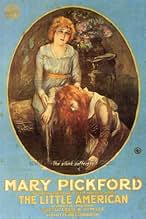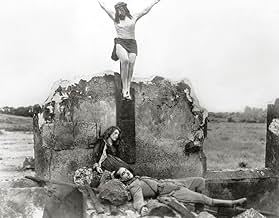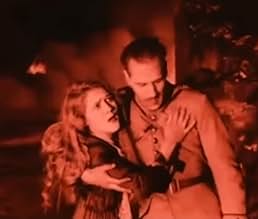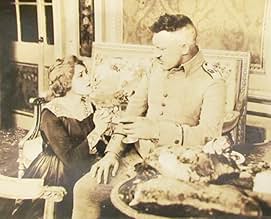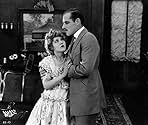Agrega una trama en tu idiomaA young American has her ship torpedoed by a German U-boat but makes it back to ancestral home in France, where she witnesses German brutality firsthand.A young American has her ship torpedoed by a German U-boat but makes it back to ancestral home in France, where she witnesses German brutality firsthand.A young American has her ship torpedoed by a German U-boat but makes it back to ancestral home in France, where she witnesses German brutality firsthand.
- Dirección
- Guionistas
- Elenco
Wallace Beery
- German Soldier
- (sin créditos)
Olive Corbett
- Nurse
- (sin créditos)
Lucile Dorrington
- Nurse
- (sin créditos)
Clarence Geldert
- Submarine Commander U-Boat 21
- (sin créditos)
Carl Gerard
- Reverend
- (sin créditos)
Robert Gordon
- Wounded Soldier
- (sin créditos)
Gordon Griffith
- Child
- (sin créditos)
Opiniones destacadas
This film is blatantly an anti-German propaganda film to which audiences flocked because America declared war on Germany a few months before its release. It's very effective even today, as I found myself despising the Germans for their actions, which included killing civilians and raping some women. Mary Pickford plays the title character, uncharacteristically a grown woman instead of a child she played in most of her films during the silent era. She is wooed by German-American Jack Holt and French-American Raymond Hatton when war breaks out in 1914. The Germans are depicted as being overly brutal.
There was one scene that made me laugh, when the Germans break the door down to enter her aunt's home. Mary tells them in deadly ernest while waving a small American flag, "Gentlemen - you are breaking into the home of an American citizen - I must ask you to leave." The Germans, led by Walter Long, roared with laughter too. I couldn't decide if it was comic relief or if you were suppose to sympathize with Mary.
I rather enjoyed the film for what it was. It was paced well by DeMille and the acting was fine but typical of early silents. Walter Long made a good heavy - he can sneer with the best of them.
You may notice in the cast list some famous names (Wallace Beery, Ramon Novarro, etc.) without character names. You never actually see these actors, but they are known to have been in the film from various writings, including DeMille's autobiography.
There was one scene that made me laugh, when the Germans break the door down to enter her aunt's home. Mary tells them in deadly ernest while waving a small American flag, "Gentlemen - you are breaking into the home of an American citizen - I must ask you to leave." The Germans, led by Walter Long, roared with laughter too. I couldn't decide if it was comic relief or if you were suppose to sympathize with Mary.
I rather enjoyed the film for what it was. It was paced well by DeMille and the acting was fine but typical of early silents. Walter Long made a good heavy - he can sneer with the best of them.
You may notice in the cast list some famous names (Wallace Beery, Ramon Novarro, etc.) without character names. You never actually see these actors, but they are known to have been in the film from various writings, including DeMille's autobiography.
With the Great War ravaging Europe as this film was made, it's a clear signal of patriotism from star Mary Pickford as she depicts the feisty "Angela". She's from wealthy stock and on her birthday is being courted by French "Count Jules" (Raymond Hatton) and by her slight favourite, the Prussian soldier "Karl" (Jack Holt). Before she has to make any choices, though, both head to their respective homes to fight. Shortly thereafter, she decides to travel to her aunt's home in France only for her liner to be torpedoed and for her to find that when she eventually arrives at her stately pile that the Bosch are intent on billeting there and behaving abominably too. Her American status gives her a degree of protection so long as she stays out of the conflict, and her stiff-necked friend "Karl" is amongst the occupiers, but when their cruelty to the house's staff and to an elderly gent shock her to the core, she decides that she can no longer stay on the fence. What now ensues sees her bravely attempt to help the Allied forces at great peril not just to her, but to her friend who would try to keep her as alive as his upbringing would permit! That merely invites a trial for espionage and treason and a firing squad for both of them looms... Can they find a way to escape the bullets? This is an effective propaganda tool, this film, illustrating just how ghastly the enemy were; how indiscriminate their violence was inflicted and how generally boorish and superior they were. Pickford and Cecil B. DeMille clearly wanted to ram that point home to domestic audiences and on that front they are quite effective. It really could have done with some more light, but even dingy as it is it delivers quite a potent analysis of uniformed thuggery tempered by conflicted romance and a semblance of human decency. It has it's zealous moments - from all sides, and in it's way it is quite a tough film to watch as though not graphic in terms of photography, it is in terms of psychology. It has a clear message to send and is worth a watch, I'd say.
Mary Pickford ("Born on the Fourth of July" as Angela Moore) is "The Little American" (of French heritage); she falls in love with Jack Holt (as Karl Von Austreim), who had moved to America with his German father and American mother. French-American Raymond Hatton (as Count Jules de Destin of the "Fighting Destins") has fallen in love with Ms. Pickford. The love triangled threesome eventually wind up in France, with the Great War (World War I, in hindsight) complicating their lives considerably.
A mostly entertaining, if propagandistically flawed, Cecil B. DeMille film. The torpedoing, and sinking, of a ship carrying Pickford is "Titanic"-like. The war intrigue gets dramatic as Pickford slowly becomes an undercover spy for France, while the Germans occupy her ancestral home. Of course, German lover Holt arrives. It was difficult to believe they took so long to recognize each other as he moved in for the rape, but it was dark; and, prior events had them believe each other dead. The film goes WAY over-the-top in its symbolism. Pickford was, by the way, Canadian - though, few could deny she wasn't a "Little American", for all intents and purposes.
FUN to spot "extras" who later became major stars include Wallace Beery, Colleen Moore, and Ramon Novarro - especially, watch for Mr. Novarro exhibiting "star" quality during one of the film's more memorable sequences: Pickford and the wounded soldier saluting each other as he is taken by her on a stretcher. Novarro even gets Mary Pickford to write a letter for him; obviously, he's got a future in pictures. Also future-bound is Ben Alexander, who plays the boy "Bobby"; he becomes a dependable child actor, and grows up to become a Jack Webb partner on "Dragnet".
******* The Little American (7/12/17) Cecil B. DeMille ~ Mary Pickford, Jack Holt, Raymond Hatton
A mostly entertaining, if propagandistically flawed, Cecil B. DeMille film. The torpedoing, and sinking, of a ship carrying Pickford is "Titanic"-like. The war intrigue gets dramatic as Pickford slowly becomes an undercover spy for France, while the Germans occupy her ancestral home. Of course, German lover Holt arrives. It was difficult to believe they took so long to recognize each other as he moved in for the rape, but it was dark; and, prior events had them believe each other dead. The film goes WAY over-the-top in its symbolism. Pickford was, by the way, Canadian - though, few could deny she wasn't a "Little American", for all intents and purposes.
FUN to spot "extras" who later became major stars include Wallace Beery, Colleen Moore, and Ramon Novarro - especially, watch for Mr. Novarro exhibiting "star" quality during one of the film's more memorable sequences: Pickford and the wounded soldier saluting each other as he is taken by her on a stretcher. Novarro even gets Mary Pickford to write a letter for him; obviously, he's got a future in pictures. Also future-bound is Ben Alexander, who plays the boy "Bobby"; he becomes a dependable child actor, and grows up to become a Jack Webb partner on "Dragnet".
******* The Little American (7/12/17) Cecil B. DeMille ~ Mary Pickford, Jack Holt, Raymond Hatton
According to his autobiography The Little American is the film that Cecil B. DeMille wanted to make with Mary Pickford. Both were strong supporters of the Allied cause in World War I. But Adolph Zukor wanted a box office draw with a western so A Romance Of The Redwoods was done first. DeMille envisioned The Little American as part of his contribution to the propaganda war effort. And Pickford was well known for her bond tours with her husband Douglas Fairbanks.
The Little American has Mary Pickford a daughter of the a US Senator and being courted by two men, German-American Jack Holt who receives orders to return to the Fatherland for an officer's commission in the newly declared war and French diplomat Raymond Hatton similarly ordered home. Pickford's family has a château in France and she travels there to be a nurse. But her ocean liner is torpedoed like the Lusitania and she eventually gets there.
But as it turns out the château is in German occupied territory and she's asked to do a little espionage. And who do you think is among the Germans occupying, none other than Holt.
As this was a film that DeMille himself labels a contribution to the war effort a lot of it can be dismissed. Pickford was her heroic best as The Little American. Some aspects of the real life Edith Cavell story are incorporated here with a lot more happy ending.
As for the German atrocities. They'd have to wait until the next war when Hollywood couldn't make up what they did in real life.
The Little American has Mary Pickford a daughter of the a US Senator and being courted by two men, German-American Jack Holt who receives orders to return to the Fatherland for an officer's commission in the newly declared war and French diplomat Raymond Hatton similarly ordered home. Pickford's family has a château in France and she travels there to be a nurse. But her ocean liner is torpedoed like the Lusitania and she eventually gets there.
But as it turns out the château is in German occupied territory and she's asked to do a little espionage. And who do you think is among the Germans occupying, none other than Holt.
As this was a film that DeMille himself labels a contribution to the war effort a lot of it can be dismissed. Pickford was her heroic best as The Little American. Some aspects of the real life Edith Cavell story are incorporated here with a lot more happy ending.
As for the German atrocities. They'd have to wait until the next war when Hollywood couldn't make up what they did in real life.
When the US entered World War I, the government forced Hollywood to churn out propaganda films. THE LITTLE American is probably the best of the lot because it stars Mary Pickford.
Pickford plays a young woman torn between two men: Jack Holt (German) and Raymond Hatton (French), but her decision is delayed because of the war as both men enlist.
When the ship Pickford is sailing on is sunk by the Germans (think Lusitania) because it is carrying munitions, Pickford has a great scene as she stands on the lifeboat and yells at the German commander. Later on, of course, she runs into both Holt and Hatton when she is being held as a war prisoner at a château.
Director Cecil B. DeMille provides one truly great scene in this film as Pickford and Holt are wandering through a bombed-out village. They pass a destroyed church of which only one wall remains standing. Against the wall is a very large crucifix. As they stand and watch, the wall collapses but the Jesus figure remains, suspended in mid air. It's a very surreal moment in a film that is otherwise very straightforward and un-artsy.
Pickford is, as always, a pleasure to watch. She was always a very natural actress who avoided the arm-waving histrionics many other actors of the day used. She's also very very pretty. Holt is very good here in a leading-man role. Hatton is OK. Among the list of name actors in "extra" parts are Wallace Beery, Ramon Novarro, Colleen Moore, Ben Alexander, Hobart Bosworth, Norman Kerry, Walter Long, James Neill, and Edythe Chapman.
Not a great film, but interesting to see US propaganda at work.
Pickford plays a young woman torn between two men: Jack Holt (German) and Raymond Hatton (French), but her decision is delayed because of the war as both men enlist.
When the ship Pickford is sailing on is sunk by the Germans (think Lusitania) because it is carrying munitions, Pickford has a great scene as she stands on the lifeboat and yells at the German commander. Later on, of course, she runs into both Holt and Hatton when she is being held as a war prisoner at a château.
Director Cecil B. DeMille provides one truly great scene in this film as Pickford and Holt are wandering through a bombed-out village. They pass a destroyed church of which only one wall remains standing. Against the wall is a very large crucifix. As they stand and watch, the wall collapses but the Jesus figure remains, suspended in mid air. It's a very surreal moment in a film that is otherwise very straightforward and un-artsy.
Pickford is, as always, a pleasure to watch. She was always a very natural actress who avoided the arm-waving histrionics many other actors of the day used. She's also very very pretty. Holt is very good here in a leading-man role. Hatton is OK. Among the list of name actors in "extra" parts are Wallace Beery, Ramon Novarro, Colleen Moore, Ben Alexander, Hobart Bosworth, Norman Kerry, Walter Long, James Neill, and Edythe Chapman.
Not a great film, but interesting to see US propaganda at work.
¿Sabías que…?
- TriviaFilm debut of Ramon Novarro.
- ErroresWhen Angela is returning to her bedroom after taking off the German commander's boots, the shot of her approaching the door is shown twice.
- Citas
Count Jules De Destin: Since you are determined to stay, Mademoiselle, you may render France a great service.
- Versiones alternativasThe George Eastman House version in their Motion Picture Study Collection has an uncredited piano score and runs 76 minutes.
- ConexionesFeatured in The House That Shadows Built (1931)
Selecciones populares
Inicia sesión para calificar y agrega a la lista de videos para obtener recomendaciones personalizadas
Detalles
- Fecha de lanzamiento
- País de origen
- Idioma
- También se conoce como
- Маленькая американка
- Locaciones de filmación
- 2000 De Mille Drive Los Feliz, California, Estados Unidos(Home of Cecil B. De Mille in Laughlin Park, shown in the first shot right after the opening credits)
- Productora
- Ver más créditos de la compañía en IMDbPro
Taquilla
- Presupuesto
- USD 166,949 (estimado)
- Tiempo de ejecución1 hora 20 minutos
- Mezcla de sonido
- Relación de aspecto
- 1.33 : 1
Contribuir a esta página
Sugiere una edición o agrega el contenido que falta

